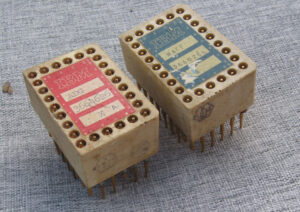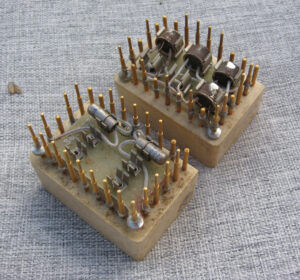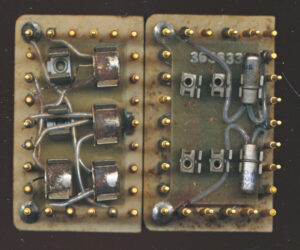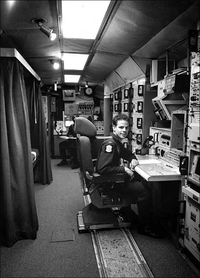The IBM 4020 Military Computer – Tracking Missiles with 6-bit Bytes
Back in the late 1950’s two things were happening (ok more then 2 but 2 relevant to todays discussion) the military was looking to replace the new but now already out of date tube based SAGE and AN/FSQ-7 Strategic Air Command (SAC) computers, and multiple bits of data were beginning to be called bytes. The SAC was in charge of all of the US’s Strategic bombers, ICBMs, and detecting/tracking the threats of bombers/ICBMs from the USSR. The older tube based SAGE computer was designed for relaying, consolidating, and displaying data from Early Warning RADARs across North America to paint a situation picture of what was going on. It worked fine, for bombers, but the late 1950’s also brought about ICBMs, and ICBMs are much much faster then mere bombers. The SAGE, and the AN/FSQ-7 lacked the processing speed to keep up with the changing data from a RADAR track of an ICBM so something faster was needed.
IBM developed and proposed the AN/FSQ-31 (and the FSQ-7A which got renamed the FSQ-32) which were based on the newly developed IBM 4020 military computer. The IBM 4020 was completely transistor based and designed for reliability and speed. Marketing materials of the time refer to its ‘resistance to the effects of nuclear blast,’ clearly this was the 1950’s. At the heart of the 4020 designs was the Q-Pac. These were pluggable, ceramic encapsulated circuit packages. The majority of all logic requirements can be met
by seven basic types of Q-Pacs, each containing from one to four circuits. The use of transistors, diodes, and resistors/caps on each Q-Pac served as what TTL/RTL of the 1960’s/1970’s formed, discrete logic elements, albeit simple ones. In the 4020 the computer was divided into modules (racks) which each contained 16 drawers. Each drawer could hold 96 individual Q-Pac (or 48 double Q-pacs). That’s 1536 logic elements per module, and the 4020 had 8 modules, resulting in around 12,288 Q-Pacs. It appears each Q-pac could support 6 discrete transistors, so the 4020’s basic data path (not counting memory, I/O or storage subsystems would max out at 73k transistors. Obviously there would not be a system that was ALL transistors but this gives us an idea of the scale of the computer. This is around what the Motorola 68000 CPU had or a Intel 80186. The typical 4020 (again not counting the peripherals) was water cooled, used 13kw of power and took a good 85 sq ft of floor space.
The 4020 was a 48-bit word length (pus 2 parity bits) computer and was capable of around 400,000 Instructions per second with a 2.5microsecond cycle time (6.25MHz). It supported 128kwords of drum storage (remember 48 bit words, so this is about 6Mbit. The 4020 also supported byte processing, using the 48-bit word as 8 6-bit sections which IBM called bytes. This is one of the first official commercial usages of the term ‘byte’ for a chunk of data. We think of bytes as 8-bits but thats only a standard thats been around the last 30 years or so. Back in the 1950’s it was the wild west of data naming. It was common to use 6-bits for BCD (Binary coded Decimal) and 6-bits to represent characters, so a 6-bit byte was only natural for IBM to use. This eventually gave way to the 8-bit bytes we all know and love by the late 1960’s, though some processors even in the 1970’s used 12-bit words (Intersil 6100 and some PICs) and other oddities (14 bits from the PIC16).
The process of integrating the 4020’s into SAC facilities took longer then expected, not being completed until 1968, by which time they were of course outdated again. By 1975 most of them had been replaced by newer Honeywell systems. Interestingly, the 4020’s tube driven predecessor lasted in some bases until the early 1980’s.
It wouldn’t surprise me if, even after 60+ years, these Q-Pac modules still worked, after all, that was their intended design, to be rugged and reliable.
The Q-Pacs are in a lot of ways an early predecessor the IC’s of today, a single module containing various logic elements, while not on a silicon die, they were ‘built’ by hand, on a ceramic substrate.






October 23rd, 2021 at 6:36 am
“We think of bytes as 8-bits but thats only a standard thats been around the last 30 years or so.”
No, it was the most common size of a byte in microprocessors ever since the mid-to-late 1970s.
October 23rd, 2021 at 10:06 am
Indeed it was most common even back then, but wasnt actually made an ISO standard by definition until 1993 (in ISO/IEC 2382-1:1993)
April 24th, 2022 at 7:05 pm
So, were there any components or circuitry embedded within the ceramic package? It appears from the description of photos that each Q-Pac’s functionality was determined by the components mounted underneath the ceramic package? If this is the case, then why have such a large ceramic package?
April 26th, 2022 at 1:01 am
Heat dissipation and thermal/mechanical stability.